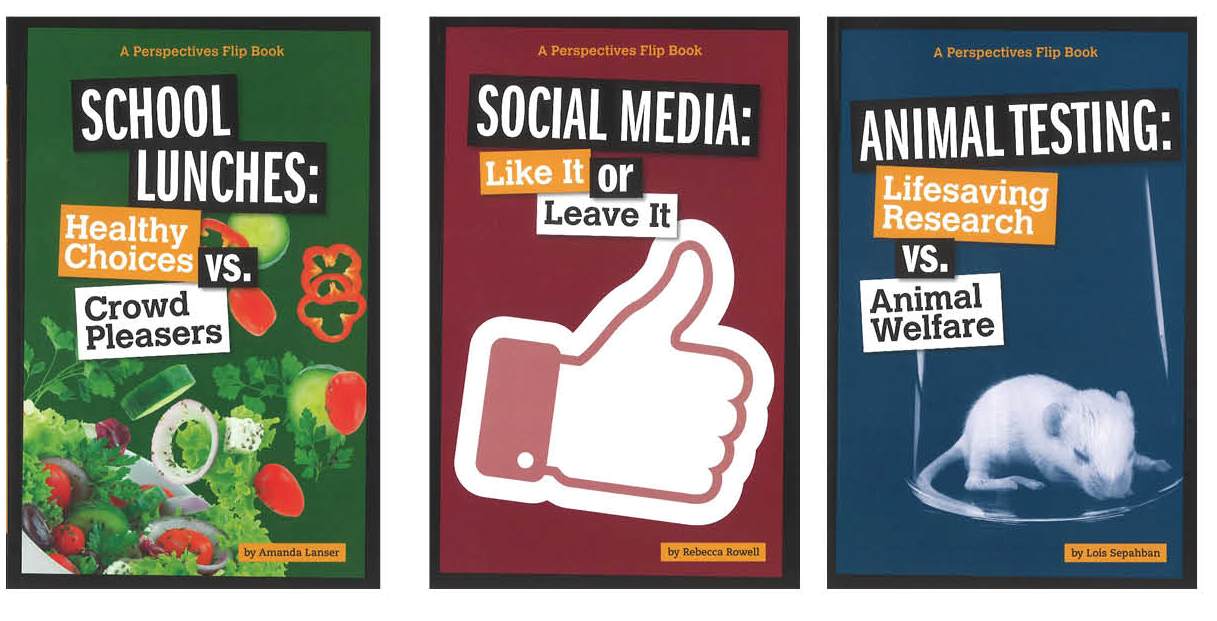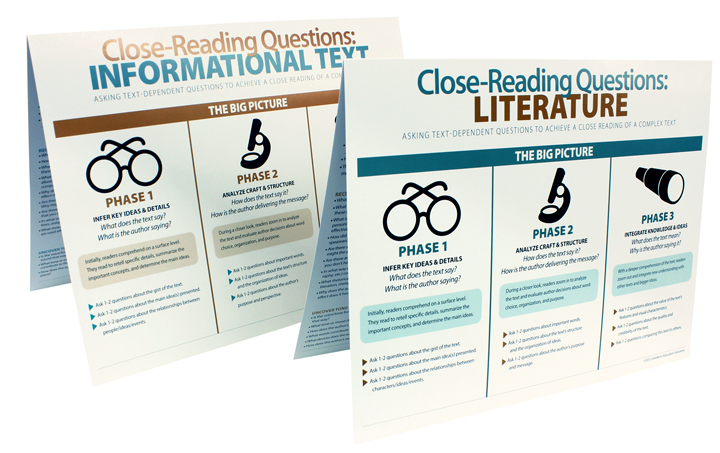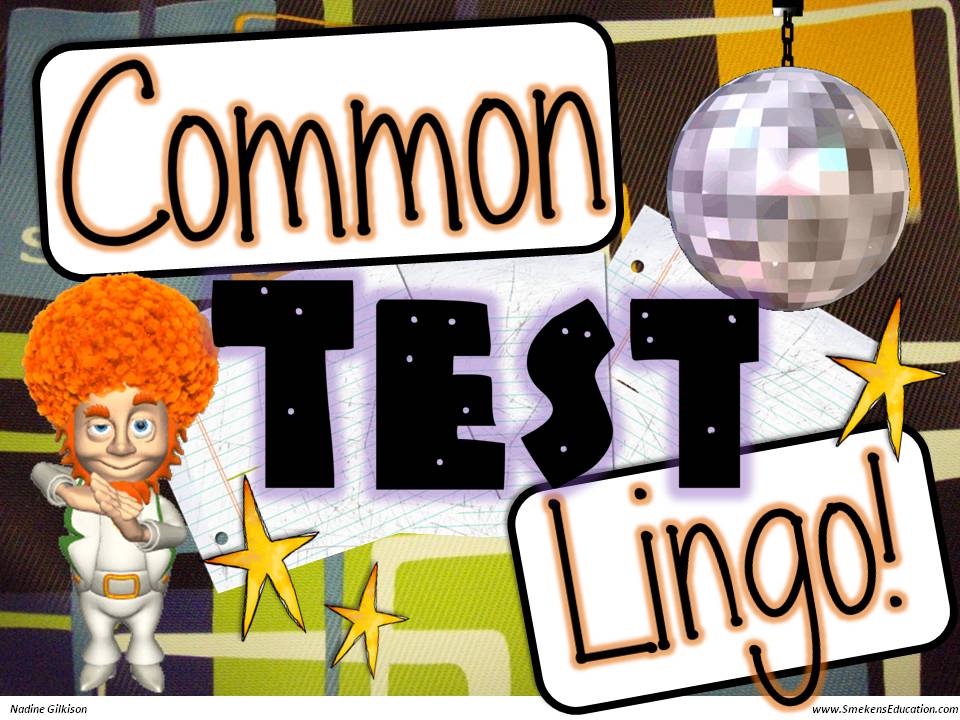18 Power Strategies
to Boost Reading & Writing Achievement on Stadardized Tests
SECRET SITE
Quick Links
Skills 1-8 | Skills 9-18
SKILL #9 Assess the strength of author ideas
Introduce facets of argumentative text
To evaluate an author’s ideas, students need to identify his claim and the support provided. Use the table top and legs approach to introduce this to students.
Define types of evidence
Watch a video of Kristina explaining how to analyze an argument.
All evidence is not equal. Introduce different types of evidence.
The expertise of the author ways heavily in the effectiveness of an argument. This is especially true in historical text.
Evaluate the text
Initially, use short argumentative text by an author with a very obvious perspective on the topic. These resources work well:
-
Book/Movie/CD reviews
-
Opinions/editorials
-
Sports columns
-
Speeches
-
Essays
-
Supreme Court decisions
Often students have to generate a constructed response that goes beyond identifying an author’s claims. They need to evaluate the quality of his argument. I love this skeletal frame by Roz Linder in Chart Sense: Grades 3-8.
SKILL #10 Draw comparisons across multiple texts
When asked to compare texts, students are NOT to write about which one they “like better.” They are to critique relevant components of both texts.
Start with a T-Chart organizer. This allows students to keep specifics for both texts separate, but parallel. Be sure to add a middle column to note the categories of comparison.
Compare 2 similar texts
-
Look for 2-3 similar ideas or facets that are addressed in two informational texts. These common ideas will serve as the categories in the T-Chart.
-
List the story elements as the categories for comparing two literary texts.
Compare perspectives
-
Same fairy tale from different cultures (Cinderella v. The Rough-Faced Girl, Little Red Riding Hood v. Lon Po Po).
-
Same story (The Three Little Pigs v. The True Story of the Three Little Pigs!, Goldilocks and the Three Bears v. Deep in the Forest).
-
The Split History Flipbook series explains the two major positions on historical events.
-
The Perspectives Flipbook series explains the two major positions on contemporary issues.
-
Contemporary/modern version versus an older work.
-
Some picture books include multiple perspectives within a single text: The Day The Crayons Quit, Voices in the Park.
Compare 2 different texts
When the two texts being compared are not the same genre, it’s sometimes harder to know where to start.
-
Compare a historical account v. a fictional account.
-
Compare an informational text to a poem on the same concept.
-
Compare an informational text to a literary nonfiction picture book.
The comparative features are less obvious. However universally these three will apply:
Informational Text
People
Note those involved, physical characteristics, attitudes and beliefs, motivations and challenges.
Time & Place
Note the time period, the geographic location, the physical environment, the social environment.
Important Events
Note the big ideas, conflicts, problems, actions, discoveries, etc.
Literature
Important Events
Note details about the plot (e.g., problems, conflicts, relationships, outcomes, etc.). What is happening and how is it affecting those involved?
Time & Place
Note details about the setting that are authentic to the time period. Note those that strayed from reality.
Important Events
Note details about the plot (e.g., problems, conflicts, relationships, outcomes, etc.). What is happening and how is it affecting those involved?
Compare print text to other medias
When the two texts being compared are not the same media type, it’s sometimes harder to know where to start.
-
Compare a transcript to the audio version of the same speech.
-
Compare a newspaper article to a television news report on the same event.
The secret is to critique the different text formats based on their value to the reader. Identify two broad categories of comparison:
-
PROS—What are the reader benefits, pros, perks, or values of this text type?
-
CONS—What are the challenges or shortcomings for the reader when faced with this text type?
Take video notes
When one of the texts to be compared is a video, make sure students watch the clip multiple times, adding to their notes as they observe details.
- The first view is for gist and overall understanding of the content.
- The second viewing is to make specific notes on what is observable. (This is quantitative evidence that be referenced in a question response.)
- Play the video a third time, but this time to look at your note-taking and NOT the screen. Focus on the audio only. Jot literal sounds, noises, music, silence, etc. that are details in this multimodal text.
VideoNot.es allows students to type time-stamped notes while watching the video on a split screen. This fabulous note-taking tool is available through Google Drive. View these tutorials for how to access it and how it works.
SKILL #11 Anticipate the close-reading framework
The standards are organized in a way that deepens reader understanding of a complex text. This is also the progression of the text-dependent question skills we will see on the assessment.
Introduce the Close-Reading Framework
When facilitating students through a complex text, sequence your questions to deepen their understanding with each reading.
- GLASSES: Initially, readers comprehend on a surface level. They read to paraphrase/retell specific details, summarize the important concepts, and determine the main ideas.
- MICROSCOPE: During a closer look, readers zoom in to analyze the text and evaluate author decisions about word choice, organization, and purpose.
- TELESCOPE: With a deeper comprehension of the text, readers zoom out and integrate new understanding from the text with other texts and bigger ideas.
Consider a question makeover
-
Tweak your everyday comprehension questions to honor the more rigorous questions on the Question Matrix (Karin Hess).
-
Watch a short video as Kristina explains what makes a question text-dependent.
Purchase a Close-Reading Questions set that includes both literature and informational text (also sold separately: Informational Text / Literature).
Download a Question Matrix planner (PDF).
SKILL #12 Decode the question/prompt
This article, published by The Text Matters Project, includes research about students’ habits when taking open-ended assessments. In addition to the common mistakes students make, it also offers numerous strategies to support them in preparing for these high-stakes exams.
Utilize Ralph Fletcher’s R.U.P.R. strategy
READ the entire prompt.
- Which sentences are simply context building?
- What is the task-based sentence?
UNDERLINE key words.
- What smaller ingredients or tasks must be in the response?
- What is the purpose?
- Is an audience identified?
- What is the specific topic?
- Is a format or genre required?
PRE-WRITE your written response.
- Students can utilize blank paper/scratch paper for taking notes and/or pre-writing their responses.
- Be explicit about the audience students are writing to. They need to know YOU are not scoring their assessments. Someone they do not know will read and score them. This is the concept of the mysterious Test Lady™. Students might even draw portraits of what they think the Test Lady™ looks like.
REREAD the prompt once more.
- Do you understand the task?
- Have you planned all the required facets?
- Did you find some wording from the prompt to use in your introduction?
Troubleshoot academic vocabulary
- Identify words/phrases your students would not recognize.
- Provide explicit instruction on a few terms at a time by comparing the complex term to simpler synonyms.
- Shift your teacher talk to utilize this academic vocabulary regularly.
Access an editable PowerPoint template to type in the key terms and simple definitions your students need.
Watch a short video of Kristina explaining the importance of academic vocabulary in decoding questions/prompts.
SKILLS #13-15 Respond to complex writing tasks
Modify frames
Here are common extended-response/writing prompt frames. Print each one and then modify them to fit the text(s) your students read closely.
Study the scoring rubrics
PARCC Extended Response Prompt
Smarter Balanced Performance Task
4-Point Writing Rubric
2-Point Conventions Rubric
New SAT Essay
The 2016 ISTEP+ and English 10 ECAs will include three sessions in PART 1 (open-ended/applied skills portion). Page 3 of this downloadable document identifies the minutes per session per grade level. However, the last set of bullets on page 1 is important to read carefully!
-
Session 1 is taken on one day (read/answer questions in 35 minutes).
-
Session 2 is taken on another day—and includes reading passage(s) and answering a couple multiple choice questions in 25 minutes.
-
Session 3 is taken the same day as Session 2 (after a short break)—and includes 55-60 minutes to write a long prompt-response based on the same text(s) read in session 2.
Organize “research”
To generate strong responses in limited time, students need to have a method to efficiently read and collect the needed information in order to write a persuasive/argumentative response.
-
When juggling 2 or more texts, use this organizer to separate evidence noted from each passage provided.
Utilize a pre-write
Organizing the research is different than actually planning out the response. Now that students have accumulated the reading and research process, they need to determine the order to present it in.
-
If the task generates an informative response, then a traditional graphic organizer is appropriate (e.g., web, outline, timeline, T-Chart, etc.).
-
If the task generates a persuasive or argumentative response, then the students need a different strategy to organize their thoughts—Persuasive pre-write (1 sided), Argumentative pre-write (2 sided).
Access more resources
For more information and resources about persuasive and argumentative writing, check out these Idea Library articles.

SKILL #16 Understand evidence v. details
Notice details, then make an inference
-
SAY/MEAN TEMPLATE: Students infer what text MEANS—What is the answer? But they must root it in what the text SAYS—How do you know?
-
EVIDENCE CHEAT SHEET: Require students to support each answer/inference with text-based evidence. Use one of these 10 ways to ask How do you know?
Integrate evidence-based responses regularly
Before asking students to independently cite evidence for inferences from complex texts—start with smaller steps and simpler texts.
-
CUSTOMIZE AN EVIDENCE SORT: Provide students a statement/question and several sentences from the text(s). Students sort “evidence” statements from “just details” (editable Word version).
-
CHARACTER REPORT CARD: Determine relevant categories/subjects to assess a character (e.g., loyalty, leadership, wisdom, etc.). Assign a letter grade for each category and then provide textual evidence for each.
-
APPLES TO APPLES—Big Picture version: The students “read” or study the same 3-5 images and infer which one photo best represents the key word based on visual evidence in the pictures.
SKILL #17 Explain evidence thoroughly
Formulate strong constructed responses.
-
The Yes, MA’AM strategy outlines a simple formula that ensures students include all the essential ingredients to a powerful response.
Restate the question and provide a general answer
-
Help students learn how to restate the question using words from the original prompt. Writing words on the Scrabble tiles, students can move them around physically to reword the original prompt.
-
The PDF version needs to be printed, laminated, and cut into separate tiles. Students use write-on/wipe-off markers during a small-group or station time.
-
The Notebook version would be a great all-class lesson tool.
-
Collect evidence
-
Use the “Find Author Evidence” documents to collect the information needed to generate a Yes, MA’AM response.
-
Page Number & Evidence PDF / editable Word version
-
Page Number, Evidence, & Explanation PDF / editable Word version
-
Page Number, Evidence, Explanation, & Ranking PDF / editable Word version
-
Bring it all together
-
Crystal Callaway, fourth grade teacher at Bailly Elementary in Chesterton, IN created XL sentence strips for her white board. What a visual reminder!
-
Hold up the mini Yes, MA’AM signs to prompt students during class discussions.
-
Challenge students to keep their responses to the restricted space. This require efficient and succinct writing.
-
Practice writing constructed responses as a class using the Yes, MA’AM graphic organizer. (Notebook version available.)
-
Motivate students to flip/scroll back through the text to find evidence.
Develop longer, extended responses
-
The Yes, MA’AM strategy can be adapted to fit the requirements of an extended reading response, as well.
-
Students can practice generating a complete response with three Yes, MA’AM reasons.
SKILL #18 Weave in specific citation
Provide explicit instruction on how to weave the what, which, and where details into a textual citation.
Regardless of what state you teach in, all our students are held to the standard of college and career-ready expectations. That said, here are several resources that offer practice tests, passages, and answer keys for grades 3-12.
- Smarter Balanced has sample items and tasks for Grades 3-8 and Grade 11.
- Test-released questions from the The New York Regents Exam are available for grades 3-8 and grades 11-12.
- At this link you’ll find a great video explaining how the new SAT differs from the former version. This would be helpful to show your HS students!
- The Reading & Writing Project offers texts sets (organized by grade levels) including passages, videos, and assessment questions. (Click on “Resources,” then “Assessments,” then “Reading & Writing Performance Assessments.”




